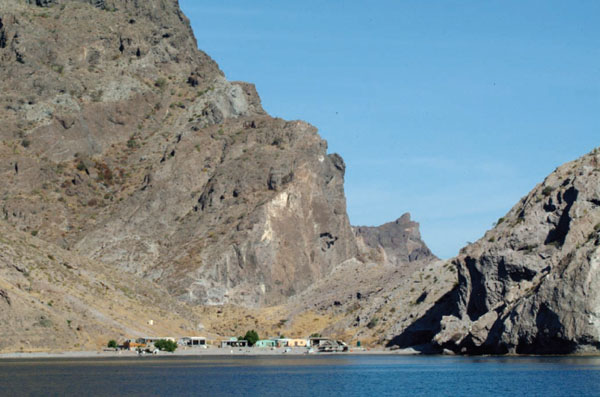

A fishing village on the Baja coast—it can be approached only by sea.
Perhaps California could never have contained restless John Steinbeck. Since his early twenties, he had dreamed of other places: his first trip out of the state was to New York City at age 23; his second was to Mexico City at age 33.
Mexico long attracted Steinbeck, and from 1935 to 1949 he made repeated trips south—as tourist, as writer, as filmmaker. “There’s an illogic there I need,” he said in 1948, after Ed Ricketts’s death. For Steinbeck, Mexico seemed an objective correlative of his worldview, a place not primitive—a word having uncomfortable connotations—but primary, having a different set of values from those of his own nation, a simpler, seemingly kinder, more generous approach to life. More than a third of his work includes Mexican characters or focuses on Mexican culture—Tortilla Flat, Sea of Cortez, and The Pearl (1947); scripts for The Forgotten Village (1941), A Medal for Benny (1945), and Viva Zapata! (1952); and the short story, “The Miracle of Tehepac.” He fully embraced the country’s history and culture.

Steinbeck, circa 1960.
Steinbeck absorbed Mexico long before he went there. In Steinbeck’s California, the Spanish/Mexican presence was—and remains—everywhere: in Monterey adobes, in tamales sold in cafés, in a large Mexican-American population; in the lilt of Spanish heard and read; in Spanish place-names: Salinas, Soledad, San Juan Batista, Monterey, Corral de Tierra, the Santa Lucia Mountains, and the Gabilans. Young Steinbeck’s friends, the Wagners, had fled the Mexican revolution to live in Salinas. A sense of the exotic must have clung to things Mexican for young Steinbeck. In The Red Pony, Jody is fascinated with the old paisano’s rapier, a sword of dignity that intrigues Jody as much as does old Gitano himself.
The idea of Mexico fired Steinbeck’s imagination, but it would take him years to actually visit the country. In 1932, he wrote to his agent Elizabeth Otis that he was going to Mazatlán,
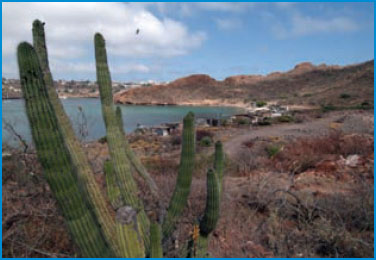
San Carlos, Sonora
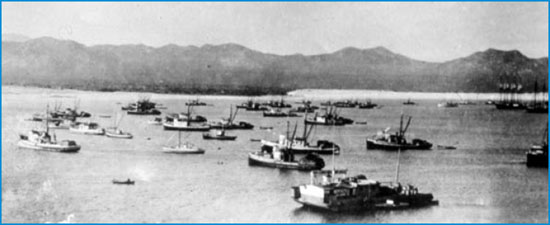
The Sea of Cortez as it looked to Steinbeck and Ricketts.
and from there I shall go on horseback in the general direction of Guadalajara … [I want] entrée into a number of tiny villages … I plan to do a series of little stories on the road—local sagas…. Such things might well be done with simplicity, with color and with some charm, if one were able to present the incident against its background and at the same time permeate it with the state of mind of its community.
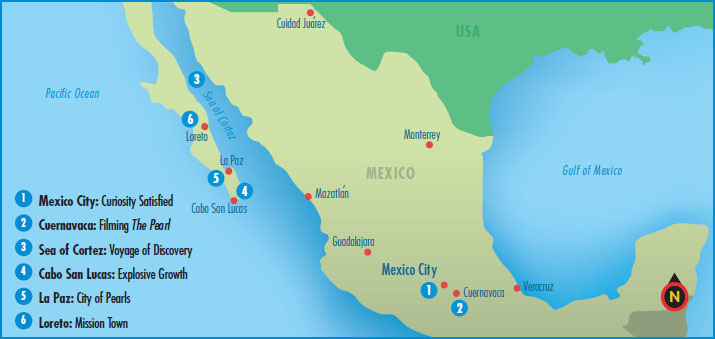
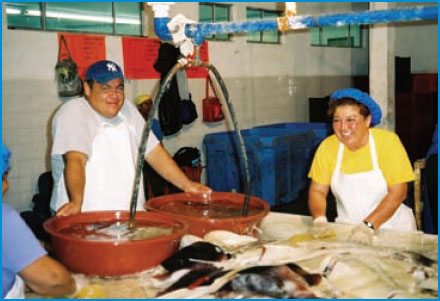
Processing squid in Santa Rosalia; once processed, the squid is trucked to Mexico City. In a few towns on the Sea of Cortez, the nontourist economy is focused on squid fishing.
Although financial worries and his mother’s stroke prevented that trip, much in the planning of it is pure Steinbeck—that quest for the marrow of a place, seeing the layers of incident, culture, and place as one. A year later he wrote his agent that he wanted to write about “Mexicans and Yuakis taken from jails in Northern Mexico” to work in Spreckels’ fields; that book didn’t materialize either. The trip he eventually took in 1935, when freed of financial worry, was by car down a newly opened highway to  Mexico City. In 1940 he returned to Baja on a Monterey purse seiner on his expedition with Ed Ricketts. Being drawn to Mexico is part of the mythos of discovery and rebirth Steinbeck enacted in his fiction. His western settlement narratives, which so often end in disappointment, are upended by the possibility of another kind of migration, “southering,” looking to another historical, cultural, and ecological frontier.
Mexico City. In 1940 he returned to Baja on a Monterey purse seiner on his expedition with Ed Ricketts. Being drawn to Mexico is part of the mythos of discovery and rebirth Steinbeck enacted in his fiction. His western settlement narratives, which so often end in disappointment, are upended by the possibility of another kind of migration, “southering,” looking to another historical, cultural, and ecological frontier.
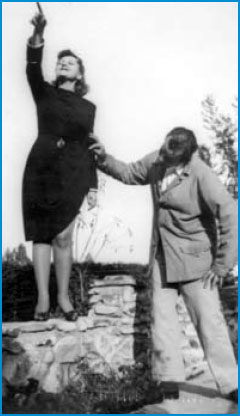
John and Gwyn in Cuernavaca, 1945.

One of the trucks that carries squid from Santa Rosalia to Mexico City.
What kept his interest in Mexico so keen? Curiosity, for one thing. Settled in a Mexico City apartment on that first trip, he wrote to his agent: “It is impossible for me to do much work here. An insatiable curiosity keeps me on the streets or at the windows. Sometime I’ll come back here to live I think.” He relished the music, festivals, and markets of Mexico and included scenes of harvesting corn and mariachi bands in his three Mexican films. Another reason for his love of Mexico was the country’s “illogic,” a meandering pace that matched his own idiosyncratic ways. His handyman on the Los Gatos ranch, Frank Raineri, noted that Steinbeck asked him about Spanish holidays and celebrations. “John liked to be around Spanish celebrations…. He liked Spanish people and liked to be with them. He liked their way of living.” Laughter also kept him interested in Mexico. In 1944, having returned from his stint as an overseas correspondent, Steinbeck lived in  Cuernavaca for a few weeks with Gwyn, his young son Thom, and their sheepdog Willie. Willie was often dognapped, a friend from that time reported, and held for ransom. Steinbeck concocted a simple solution for Willie’s return: “Steinbeck would buy a slide to be projected on the screen at the Cuernavaca movie house, offering a reward for the return of his dog. He called it a racket and in a typically profane manner denounced the thieves, but played the game.”
Cuernavaca for a few weeks with Gwyn, his young son Thom, and their sheepdog Willie. Willie was often dognapped, a friend from that time reported, and held for ransom. Steinbeck concocted a simple solution for Willie’s return: “Steinbeck would buy a slide to be projected on the screen at the Cuernavaca movie house, offering a reward for the return of his dog. He called it a racket and in a typically profane manner denounced the thieves, but played the game.”

Willie the sheepdog, victim of repeated dognappings.
Mexican history drew him. When he was working on the script of Viva Zapata, Steinbeck kept thinking about the Alamo and Santa Ana as the real hero—the subject for another film. Steinbeck entered into the soul of Mexico as fully as he was able, embracing its traditions, pace, and people—“considerate as only Mexicans can be.” The Indians of Mexico—dignified, gracious, poor—engaged his deepest sympathies. He loved the dry soil, the rocky hills, the blue water. The place and the culture tallied with his own sensibilities. Sea of Cortez illustrates all of these things.
Baja California is a rugged, mountainous peninsula nearly a thousand miles long that forms the western border of the Gulf of California. Cacti stand sentinel to the sea along its length. In 1940 it was a remote, dry, and unearthly place of tiny fishing villages and a richly diverse sea, a combination that had drawn explorers for centuries. Even though Francisco de Ulloa had circumnavigated the gulf and discovered the mouth of the Colorado River by 1539, a belief that the northern end of the gulf opened into the Pacific persisted well into the seventeenth century.
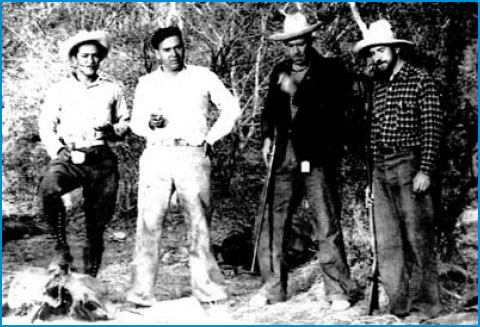
Steinbeck (center right) and Ricketts (far right) with two comrades on an expedition. This is the only known photo of the two friends together.
When Steinbeck and Ricketts sailed on the Western Flyer to  the Sea of Cortez in March 1940, their intention was clear: to see everything that this place of rich biodiversity had to reveal. Theirs was an expedition to collect marine specimens, but also a mythic trip to a legendary place—not so different, really, from the one Steinbeck had imagined for the Joads. Rather than call it the Gulf of California, Steinbeck and Ricketts refer to that body of water by its old name, the Sea of Cortez, after the legendary Spanish conquistador, “a better-sounding and a more exciting name.” On their voyage they sailed past “half-mythical places, for they are not only stormy but treacherous, and again that atavistic fear arises—the Scylla-Charybdis fear that made our ancestors people such places with monsters.” Again and again, Steinbeck refers to it as a place of mirages, where “the whole surrounding land is unsubstantial and changing,” unreal, remote, and exotic. La Paz has “a magic carpet sound to the name,” and Puerto Escondido, “the hidden harbor,” is a place of magic. Like any legendary place, this one had its heroic past, and Steinbeck and Ricketts repeatedly invoke both the accomplishments and the misconceptions of the explorers and scientists who preceded them and refer to the old histories of “sturdy Jesuit fathers” building missions on the peninsula.
the Sea of Cortez in March 1940, their intention was clear: to see everything that this place of rich biodiversity had to reveal. Theirs was an expedition to collect marine specimens, but also a mythic trip to a legendary place—not so different, really, from the one Steinbeck had imagined for the Joads. Rather than call it the Gulf of California, Steinbeck and Ricketts refer to that body of water by its old name, the Sea of Cortez, after the legendary Spanish conquistador, “a better-sounding and a more exciting name.” On their voyage they sailed past “half-mythical places, for they are not only stormy but treacherous, and again that atavistic fear arises—the Scylla-Charybdis fear that made our ancestors people such places with monsters.” Again and again, Steinbeck refers to it as a place of mirages, where “the whole surrounding land is unsubstantial and changing,” unreal, remote, and exotic. La Paz has “a magic carpet sound to the name,” and Puerto Escondido, “the hidden harbor,” is a place of magic. Like any legendary place, this one had its heroic past, and Steinbeck and Ricketts repeatedly invoke both the accomplishments and the misconceptions of the explorers and scientists who preceded them and refer to the old histories of “sturdy Jesuit fathers” building missions on the peninsula.

Steinbeck and Ricketts sailed to the Sea of Cortez on the Western Flyer, a wooden sardine purse seiner. Sixty-four years later, on March 26, 2004, a team composed of two Stanford scientists, a photographer, an environmental journalist, a captain, and a cook set out on their own two-month expedition to the gulf, sailing on the Gus D, a wooden trawler similar in size to the Western Flyer. Their purpose was to collect and count specimens in the gulf and to compare their findings to those of the 1940 trip—and to increase local conservation awareness in Mexican coastal communities.
It’s “the most difficult work I’ve ever undertaken” he wrote to New York Herald Tribune book reviewer Lewis Gannet after completing the manuscript for Sea of Cortez, and it clearly was the most hybrid—travelogue, scientist’s report, philosopher’s notes, scathing social and environmental commentary, frozen conversations, humorous asides, and poetry. The book embraces a holistic vision of a biologically rich environment, a place where the sea “swarms with life,” the land is dry and forlorn and “burned,” and Indians on “lonely little rancherias” seem “to live on remembered things, to be so related to the seashore and the rocky hills and the loneliness that they are these things.” In swells of indignant prose, Sea of Cortez asks readers to consider that a preoccupation with “external things” may be evidence of human mutation and that a preoccupation with war may be a mutation that “will see us done for,” extinct. More gently, the book draws the reader into an amalgamation of physics, metaphysics, Jungian psychology, mysticism, myth, and legend. “And then we talked and speculated, talked and drank beer.” This text orchestrates place in a symphonic mode.
Steinbeck worked on three films about the native Mexican Indians, each of which considers a problem of adjustment between the Indian culture and a culture of power. His great sense of empathy was touched by the peasants of Mexico, whose land had never been their own. In some ways, the three films mirror the pattern found in Steinbeck’s California labor trilogy: The Forgotten Village, like In Dubious Battle and “The Harvest Gypsies,” is reportorial; The Pearl, like Of Mice and Men, is parabolic; and Viva Zapata! like The Grapes of Wrath, is an epic.
The answer to why Mexico on film interested him so keenly is found in Steinbeck’s holistic sensibilities, reflected in an emblematic little incident he notes in Sea of Cortez. In Loreto, the crew sees a lovely, admittedly gaudy statue of Our Lady of Loreto under glass in a small, dimly lit chapel of the old mission. “This Lady, of plaster and wood and paint, is one of the strong ecological factors of the town of Loreto, and not to know her and her strength is to fail to know Loreto.” Steinbeck appreciated the spiritual longing represented by Our Lady, understood that Mexico’s Catholic history was as much a part of the place as the desert and Sally Lightfoot crabs and gay music that he loved. His three films help complete his own ecological embrace of Mexico.

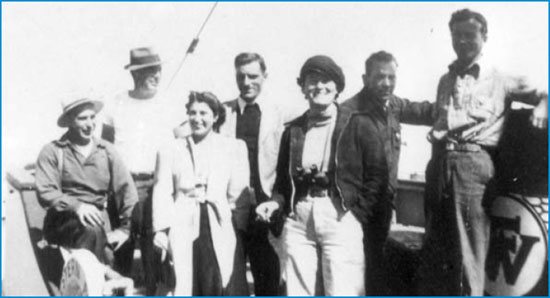
Crew of the Western Flyer before departing, March 11, 1940.
”The great rocks on the end of the [Cabo] Peninsula are almost literary.”
Tourists crowd  Cabo San Lucas beaches to soak up sun and margaritas. High-rise hotels march down the coast in what Steinbeck would have termed “Floridian ugliness.” Only the now-abandoned tuna cannery marks the forlorn little town that Steinbeck and Ricketts saw in 1940, one that had been struck by a devastating hurricane the year before: “The tuna cannery against the gathering rocks of the point and a few houses along the edge of the beach were the only habitations visible.” But the rugged rocks at the end of the peninsula, resistant to both nature’s and man’s assaults, have not changed—nor has the color of the water: “Below the Mexican border the water changes color; it takes on a deep ultramarine blue—a washtub bluing blue, intense and seeming to penetrate deep into the water; the fishermen call it ‘tuna water.’” Much of the dry, forbidding coast—where cactus and sea are thrown into sharp contrast—has not changed. On this gnarled peninsula, Steinbeck’s words still resonate.
Cabo San Lucas beaches to soak up sun and margaritas. High-rise hotels march down the coast in what Steinbeck would have termed “Floridian ugliness.” Only the now-abandoned tuna cannery marks the forlorn little town that Steinbeck and Ricketts saw in 1940, one that had been struck by a devastating hurricane the year before: “The tuna cannery against the gathering rocks of the point and a few houses along the edge of the beach were the only habitations visible.” But the rugged rocks at the end of the peninsula, resistant to both nature’s and man’s assaults, have not changed—nor has the color of the water: “Below the Mexican border the water changes color; it takes on a deep ultramarine blue—a washtub bluing blue, intense and seeming to penetrate deep into the water; the fishermen call it ‘tuna water.’” Much of the dry, forbidding coast—where cactus and sea are thrown into sharp contrast—has not changed. On this gnarled peninsula, Steinbeck’s words still resonate.
Historically, the Mexican government has pinpointed areas of the coast to develop, and when Cabo San Lucas was selected, the land was gobbled up in twenty short years. Although still-lonely coasts are being threatened by ever more hotels and houses—beach lots marked with tiny red flags—much remains untouched: little rancherias; clusters of tiny fishing shacks; fishermen going out in pangas to check nets or, out of Guaymas and Santa Rosalia, to catch huge squid on hand lines. Baja California remains a place of startling contrasts, high-rises and rancherias, cactus and sea.
 La Paz, a fabled city known as the City of Pearls, is still the queen. Although the pearl fishery had been devastated by disease and overharvesting as early as the 1750s and was essentially gone by 1940, the city still burnishes its legendary past. In 2004, a statue, The Old Man and the Sea, was added along the city’s malecón, the walkway along the harbor. When Steinbeck visited, there was a “broad promenade along the water lined with benches”; those remain. The crew enjoyed a beer in a spacious bar. They collected marine specimens on sand flats that are still healthy today. And they wondered why this town had a “home” feeling. “We had never seen a town which even looked like La Paz, and yet coming to it was like returning rather than visiting.”
La Paz, a fabled city known as the City of Pearls, is still the queen. Although the pearl fishery had been devastated by disease and overharvesting as early as the 1750s and was essentially gone by 1940, the city still burnishes its legendary past. In 2004, a statue, The Old Man and the Sea, was added along the city’s malecón, the walkway along the harbor. When Steinbeck visited, there was a “broad promenade along the water lined with benches”; those remain. The crew enjoyed a beer in a spacious bar. They collected marine specimens on sand flats that are still healthy today. And they wondered why this town had a “home” feeling. “We had never seen a town which even looked like La Paz, and yet coming to it was like returning rather than visiting.”
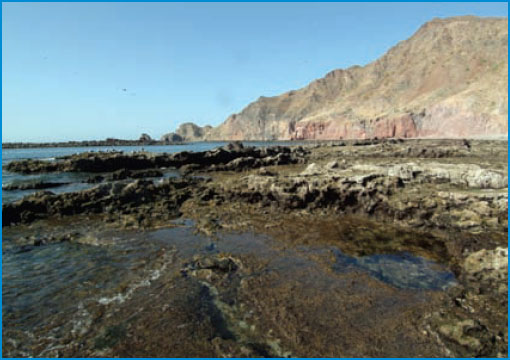
“The coastline of the Peninsula slid along, brown and desolate and dry with strange flat mountains and rocks torn by dryness, and the heat shimmer hung over the land even in March.”
In  Loreto, Steinbeck and Ricketts found “the oldest mission of all,” crumbling with decay. The Mission of Nuestra Senora de Loreto has now been restored, and a small museum displays artifacts. The town is now, as then, “asleep in the sunshine, a lovely town, with gardens in every yard and only the streets white and hot.” This image may soon change, because Loreto is the Mexican government’s most recent Baja selection for tourism development.
Loreto, Steinbeck and Ricketts found “the oldest mission of all,” crumbling with decay. The Mission of Nuestra Senora de Loreto has now been restored, and a small museum displays artifacts. The town is now, as then, “asleep in the sunshine, a lovely town, with gardens in every yard and only the streets white and hot.” This image may soon change, because Loreto is the Mexican government’s most recent Baja selection for tourism development.
Many marine animals in the Sea of Cortez remain to delight scuba divers, snorkelers, and tide-pool gazers. Rays leap from the sea, stretching in the sun. Dolphins still jump “out of the water and [seem] to have a very good time.” The jumbo Humboldt squid swim and spawn in the gulf waters, where sperm whales and other marine mammals feed on them. Beneath coastal rocks, Sally Lightfoot crabs, red “with brilliant cloisonné carapaces, walk on their tiptoes.” They scurry from human hands, and “everyone who has seen them has been delighted with them.” Starfish and brittle stars, urchins, anemones, and shrimp heavily populate rocky coastal waters. When a collector shines a light at night, puffer fish and brittle stars are illuminated, “crawling about like thousands of little snakes. They barely move about in the daylight.”
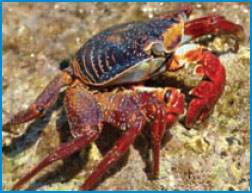
A Sally Lightfoot crab.
Many who come here wonder about the depletion of coastal resources. It’s undeniable that the Sea of Cortez is an altered place, particularly with regard to larger species. Perhaps the most dramatic example is the sea turtles that “appeared in numbers” off Magdalena Bay in 1940 and are now depleted there and elsewhere. But today they are protected and in some cases recovering. Hardly any swordfish “play about,” leaping out of the sea in the way Steinbeck describes, but one can still witness numerous sailfish and marlin jumping at the right place and time. Schools of yellowfin tuna may no longer “beat the water to spray in their millions,” but today they appear to have been replaced by vast numbers of Humboldt squid, which were not noted at all in 1940. And leviathan sperm whales are probably far more abundant than in 1940, because the squid are a favorite prey. In reality, marine ecosystems are dynamic living things that are constantly changing, and we are only beginning to appreciate the complexities involved.
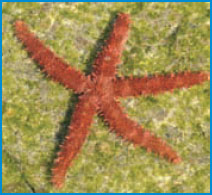
“The abundance of life here gives one an exuberance, a feeling of fullness and richness,” Steinbeck wrote. “Everything ate everything else with a furious exuberance.”
Perhaps the secrets of change lie deeper, beneath the surface of the blue waters. It is here where all marine food chains begin, with lowly planktonic organisms, many invisible to the naked eye. Changes at this foundation level can reverberate throughout the entire ecosystem to the very predators. A holistic problem indeed, and marine scientists today are struggling to understand how such changes might be influenced by long-term climate change (natural or anthropogenic), by artificial fertilization due to agricultural runoff, and by other hidden factors.
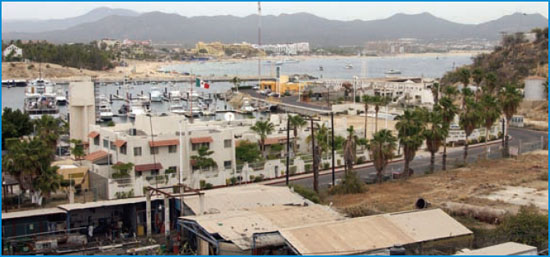
Cabo San Lucas today.
Reviewing Sea of Cortez (1941), Lewis Gannett of the New York Herald Tribune wrote that there is here “more of the whole man, John Steinbeck, than in any of his novels.” That is true, but many readers prefer the whole man light, perhaps in a book like Travels with Charley. Sea of Cortez must be savored, paragraph by paragraph. Thoughts are organic, branching off, bursting forth. And the long “Easter Sunday Sermon” by Ed Ricketts is tough going for even the most devoted Steinbeck aficionado.
Steinbeck wanted to capture in this book the quality of his long association with Ed Ricketts, their conversations, shared interests, and scientific curiosity. As he was writing the first draft, Steinbeck wrote his editor that “there are four levels of statement in it and I think very few will follow it down to the fourth. I even think it is a new kind of writing. I told you once that I found a great poetry in scientific thinking.”
If the deepest level in Sea of Cortez is mythic, another level is scientific, the poetry of the intertidal. Steinbeck, Ricketts, Carol, and the crew collected at numerous intertidal sites in the Sea of Cortez, looking at species distribution.
The catalogues of marine invertebrates, both verbal and pictorial (the 1941 edition includes Ricketts’s phyllectic catalogue), are as crucial to this book as are Whitman’s long lists to Song of Myself. The particulars of intertidal life are visual snapshots of species in broad distribution patterns, as Steinbeck writes about the first collecting site at Cabo San Lucas:

Barnacles.
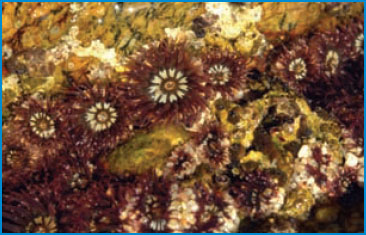
Anemones.
We collected down the littoral as the water went down…. The uppermost rocks swarmed with Sally Lightfoots, those beautiful and fast and sensitive crabs. With them were white periwinkle snails. Below that, barnacles and Purpura snails; more crabs and many limpets. Below that many serpulids—attached worms in calcareous tubes with beautiful purple floriate heads. Below that, the multi-rayed starfish, Heliaster kubiniji of Xanthus. With Heliaster were a few urchins, but not many, and they were so placed in crevices as to be hard to dislodge…. Lower still there were to be seen swaying in the water under the reefs the dark gorgorians, or sea-fans. In the lowest surf levels there was a brilliant gathering of the moss animals known as bryozoa; flatworms; flat crabs; the large sea-cucumber; some anemones; many sponges of two types, a smooth, encrusting purple one, the other erect, white, and calacareous. There were great colonies of tunicates, clusters of tiny individuals joined by a common tunic and looking so like the sponges that even a trained worker must await the specialist’s determination to know whether his find is sponge orm tunicate. This is annoying, for the sponge being one step above the protozoa, at the bottom of the evolutionary ladder, and the tunicate near the top, bordering the vertebrates, your trained worker is likely to feel that a dirty trick has been played upon him by an entirely too democratic Providence.
That layered catalogue sways with the retreating water, as intertidal collecting necessarily involves keeping one’s eye on retreating and incoming tides. A reader, like a visitor to the region, should gaze attentively at the species hidden in this dry, seemingly barren land, turn rocks carefully in the intertidal to see squirming brittle stars. To look, Steinbeck suggests, is the first step in understanding place, appreciating what is.
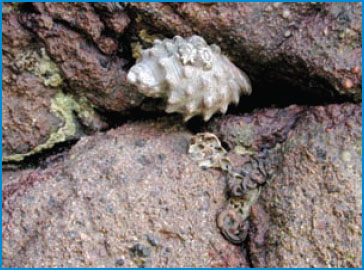
Purpura snail.

Heliaster.
For John Steinbeck, the trail out of California did not end in Mexico. He became a New Yorker. In 1941, a nasty separation from Carol propelled him back to New York City, and government work during the war kept him there. Although he returned to California twice in the 1940s to live briefly, once when married to Gwyn, he left the state for good in 1949, starting a new life in New York City with his third wife, Elaine Anderson Steinbeck.
Steinbeck’s appreciation for New York City would grow slowly. Becoming an urbanite was “rough,” he admitted in a 1953 essay, “Making of a New Yorker.” And it may be true that the transformation from man of the soil and sea to man of the streets was never quite realized. Certainly the city chastened him on his first trip when he worked as a cub reporter. Returning nearly twenty-five years later, he embraced city life with gusto: “New York is the only city I have ever lived in. It is true I have had apartments in San Francisco, Mexico City, Los Angeles, Paris, and sometimes have stayed for months, but that is a very different thing. As far as homes go, there is only a small California town and New York.” He loved his East 72nd Street house—and the apartment he and Elaine moved to across the street, with its commanding view of the skyline. He loved New York neighborhoods—”villages” really—the city’s energy, its theaters and nights at the “21 Club.”
During the last eighteen years of his life, Steinbeck was sustained by a solid marriage, money to travel as widely as his restless soul craved, urbane friends, and a little cottage that he and Elaine purchased on the Long Island Sound in Sag Harbor in 1953. Once again he returned to the sea, an essential place of his heart. “One who was born by the ocean or has associated with it,” he writes in Sea of Cortez, “cannot ever be quite content away from it for very long.”
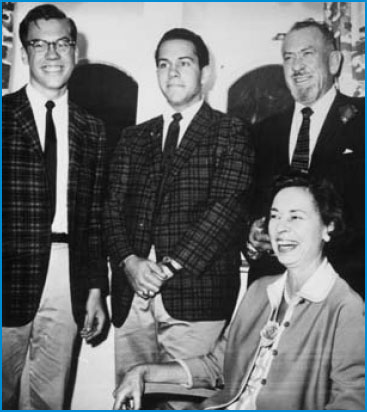
John IV, Thom, John and Elaine.
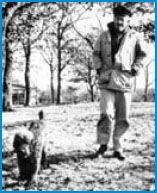
John Steinbeck and his dog Charley, 1961. Photo by Hans Namuth.
Critic upon critic has asserted that when Steinbeck left California, he abandoned his subject, the rich soil of the Salinas Valley, the fine clear water of Monterey Bay. In truth, he didn’t—he spent much of the 1950s writing about his past. But it also might be said that Steinbeck’s last loop from West Coast to East was to another frontier, a kind of psychic West that sustained and engaged him as fully as had California. In Sag Harbor, he could once again cast down his anchor, throw out his line, dream his dreams, and sing out his prose to the fishes. And in alluring and elusive New York City, married to a Texan, he could relish once again the swirl of a diverse population and soaring concrete cliffs. If his best fiction did not come from this completion of self, some of his boldest and most inventive works did. John Steinbeck, writer to the end, grasped life and art with the full-bodied grip of a westerner.
